Miele HG01 User Manual
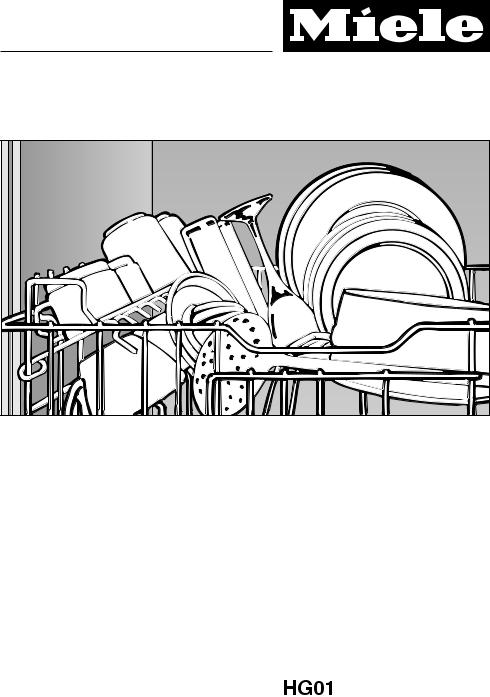
Operating instructions
Touchtronic Premier Plus
To prevent accidents |
|
UV |
and machine damage, |
|
|
read these instructions |
|
|
before |
|
M.-Nr. 05 431 301 |
installation or use. |
|
|
|

Contents
IMPORTANT SAFETY INSTRUCTIONS
CONSIGNES DE SÉCURITÉ IMPORTANTES
Caring for the environment
Guide to the dishwasher
Wash cabinet . . . . . . . . . . . . . . . . . . . . . . . . . . . . . . . . . . . . . . . . . . . . . . . . . . . . . 11 Control panel . . . . . . . . . . . . . . . . . . . . . . . . . . . . . . . . . . . . . . . . . . . . . . . . . . . . . 12
Before using for the first time
To open the door . . . . . . . . . . . . . . . . . . . . . . . . . . . . . . . . . . . . . . . . . . . . . . . . . . 13 To close the door . . . . . . . . . . . . . . . . . . . . . . . . . . . . . . . . . . . . . . . . . . . . . . . . . . 13 Child Safety Lock. . . . . . . . . . . . . . . . . . . . . . . . . . . . . . . . . . . . . . . . . . . . . . . . . . 13 Water softener . . . . . . . . . . . . . . . . . . . . . . . . . . . . . . . . . . . . . . . . . . . . . . . . . . . . 14 Salt indicator . . . . . . . . . . . . . . . . . . . . . . . . . . . . . . . . . . . . . . . . . . . . . . . . . . . . . 16 Rinse aid . . . . . . . . . . . . . . . . . . . . . . . . . . . . . . . . . . . . . . . . . . . . . . . . . . . . . . . . 17 Adding rinse aid . . . . . . . . . . . . . . . . . . . . . . . . . . . . . . . . . . . . . . . . . . . . . . . . . . 17 Adjusting the dosage. . . . . . . . . . . . . . . . . . . . . . . . . . . . . . . . . . . . . . . . . . . . . . . 18 Rinse aid indicator . . . . . . . . . . . . . . . . . . . . . . . . . . . . . . . . . . . . . . . . . . . . . . . . . 18
Loading the dishwasher
Items not recommended for dishwashing . . . . . . . . . . . . . . . . . . . . . . . . . . . . . . . 20 Cutlery tray (SC units) . . . . . . . . . . . . . . . . . . . . . . . . . . . . . . . . . . . . . . . . . . . . . . 21 Upper basket . . . . . . . . . . . . . . . . . . . . . . . . . . . . . . . . . . . . . . . . . . . . . . . . . . . . . 22 Adjusting the upper basket . . . . . . . . . . . . . . . . . . . . . . . . . . . . . . . . . . . . . . . 22 Adjustable cup racks . . . . . . . . . . . . . . . . . . . . . . . . . . . . . . . . . . . . . . . . . . . . 23 Coffee bar . . . . . . . . . . . . . . . . . . . . . . . . . . . . . . . . . . . . . . . . . . . . . . . . . . . . . 23 Lower basket . . . . . . . . . . . . . . . . . . . . . . . . . . . . . . . . . . . . . . . . . . . . . . . . . . . . . 24
Lower basket inserts
Removing an insert. . . . . . . . . . . . . . . . . . . . . . . . . . . . . . . . . . . . . . . . . . . . . . 25 Inserting an insert . . . . . . . . . . . . . . . . . . . . . . . . . . . . . . . . . . . . . . . . . . . . . . . 25 Foldable spike insert. . . . . . . . . . . . . . . . . . . . . . . . . . . . . . . . . . . . . . . . . . . . . 26 Plateguard Plus with StemGuard . . . . . . . . . . . . . . . . . . . . . . . . . . . . . . . . . . . 27 Tall Glassware Insert for lower basket . . . . . . . . . . . . . . . . . . . . . . . . . . . . . . . 28 Vase / Bottle holder. . . . . . . . . . . . . . . . . . . . . . . . . . . . . . . . . . . . . . . . . . . . . . 28
Basket accessories
2

Contents
Operation
Adding detergent. . . . . . . . . . . . . . . . . . . . . . . . . . . . . . . . . . . . . . . . . . . . . . . . . . 30 Running the dishwasher . . . . . . . . . . . . . . . . . . . . . . . . . . . . . . . . . . . . . . . . . . . . 31 Program sequence indicator (14) . . . . . . . . . . . . . . . . . . . . . . . . . . . . . . . . . . . . . 32 Time display (18) . . . . . . . . . . . . . . . . . . . . . . . . . . . . . . . . . . . . . . . . . . . . . . . . . . 32 At the end of a program. . . . . . . . . . . . . . . . . . . . . . . . . . . . . . . . . . . . . . . . . . . . . 32 Interrupting a program. . . . . . . . . . . . . . . . . . . . . . . . . . . . . . . . . . . . . . . . . . . . . . 33 Changing a program . . . . . . . . . . . . . . . . . . . . . . . . . . . . . . . . . . . . . . . . . . . . . . . 33 Program guide . . . . . . . . . . . . . . . . . . . . . . . . . . . . . . . . . . . . . . . . . . . . . . . . . . . . 34 Additional features . . . . . . . . . . . . . . . . . . . . . . . . . . . . . . . . . . . . . . . . . . . . . . . . . 35
"Top Solo" (20). . . . . . . . . . . . . . . . . . . . . . . . . . . . . . . . . . . . . . . . . . . . . . . . . . 35 Delay Start (19). . . . . . . . . . . . . . . . . . . . . . . . . . . . . . . . . . . . . . . . . . . . . . . . . 36 Extended drying . . . . . . . . . . . . . . . . . . . . . . . . . . . . . . . . . . . . . . . . . . . . . . . . 38
Frequently asked questions
After sales service
Transport
User Maintenance Instructions
Cleaning and Care
"Filter" indicator light . . . . . . . . . . . . . . . . . . . . . . . . . . . . . . . . . . . . . . . . . . . . . . . 48 Cleaning the filter in the wash cabinet. . . . . . . . . . . . . . . . . . . . . . . . . . . . . . . . . . 48 Cleaning the spray arms . . . . . . . . . . . . . . . . . . . . . . . . . . . . . . . . . . . . . . . . . . . . 50 Cleaning the wash cabinet . . . . . . . . . . . . . . . . . . . . . . . . . . . . . . . . . . . . . . . . . . 51 Cleaning the door and door seal . . . . . . . . . . . . . . . . . . . . . . . . . . . . . . . . . . . . . . 51 Cleaning the exterior . . . . . . . . . . . . . . . . . . . . . . . . . . . . . . . . . . . . . . . . . . . . . . . 51 Cleaning the water inlet filter . . . . . . . . . . . . . . . . . . . . . . . . . . . . . . . . . . . . . . . . . 52 Cleaning the drain pump and non-return valve. . . . . . . . . . . . . . . . . . . . . . . . . . . 53
3

IMPORTANT SAFETY INSTRUCTIONS
WARNING –
When using your dishwasher, follow basic precautions, including the following:
Read all instructions before installation or use of the dishwasher to prevent injury and machine damage.
The manufacturer cannot be held responsible for damage or injury caused by improper use of this appliance.
Use the dishwasher only for its intended purpose. This appliance is intended for residential use only.
Keep these operating instructions in a safe place and pass them on to any future user.
Electrical safety
Before installation make sure that the voltage and frequency listed on
the data plate correspond with the household electrical supply. This data must correspond to prevent injury and machine damage. Consult a qualified electrician if in doubt.
Before installation or service, disconnect the power supply to the
work area by unplugging the unit, “tripping” the circuit breaker or removing the fuse.
Do not use an extension cord to connect this appliance to
electricity. Extension cords do not guarantee the required safety of the appliance (e.g. danger of overheating).
Be certain your appliance is properly installed and grounded by
a qualified technician. To guarantee the electrical safety of this appliance, continuity must exist between the appliance and an effective grounding system. It is imperative that this basic safety requirement be met. If there is any doubt, have the electrical system of the house checked by a qualified electrician. The manufacturer cannot be held responsible for damages caused by the lack, or inadequacy, of an effective grounding system.
Installation
Installation and repair work should be performed by a Miele
authorized service technician. Work by unqualified persons could be dangerous and could void the warranty.
, WARNING - Fire hazard
Do not cover or crush the plug of an electric appliance. Ensure that the cabinet opening for the dishwasher provides ample space for the plug. Installing the dishwasher in a tight space may crimp the power cord or put pressure on the plug which may cause overheating.
4

IMPORTANT SAFETY INSTRUCTIONS
This equipment is not designed for maritime use or for use in mobile
installations such as recreational vehicles or aircraft. However, under certain conditions it may be possible for an installation in these applications. Please contact the nearest Miele dealer or the Miele Technical Service Department with specific requirements.
Inspect the dishwasher for shipping damage. Do not install or
operate a damaged unit. Contact the place of purchase.
Ensure that any plastic wrappings, bags etc. are disposed of safely
and kept out of the reach of children. Danger of suffocation!
This dishwasher should only be installed under a continuous
countertop secured to adjacent cabinetry.
Do not install this dishwasher beneath a cooking surface, oven or
any appliance that radiates heat.
High temperatures from these units may damage the dishwasher.
Do not, under any circumstances cut the intake hose or submerge in
liquid. This hose contains electrical components that could cause injury or property damage if cut or submerged.
Use
Only use the dishwasher if all panels are properly in place.
Do not tamper with the controls.
To reduce the risk of injury, do not allow children to play in, on, or
near the dishwasher.
Do not damage, sit, or stand on the door or baskets of the dishwasher.
Under certain conditions, hydrogen gas may be produced in a hot
water system that has not been used for two weeks or more. HYDROGEN GAS IS EXPLOSIVE. If the hot water system has not been used for such a period, turn on all hot water faucets and let water flow from each for several minutes before using the dishwasher. This will release any accumulated hydrogen gas. Do not smoke or use an open flame during this time.
Do not wash plastic items unless they are labeled "dishwasher safe"
or the equivalent. For items not labeled, check the manufacturer’s recommendations.
5

IMPORTANT SAFETY INSTRUCTIONS
When loading tableware, place sharp items away from the door seal to prevent damage to the seal. Load knives pointing downwards to
prevent injuries.
Only use detergents and rinse aids recommended for residential
dishwashers. Keep all detergents and rinse aids out of the reach of children.
Do not drink water from the dishwasher! Harmful residues
could be present.
For dishwashers with a visible heating element
Do not touch the heating element during or immediately after use.
Disposal of an appliance
If the appliance is removed from its installation and will not be used,
the door to the wash cabinet should be removed to prevent children from being locked in the machine. When discarding an old dishwasher, unplug it from the power outlet, remove the door to the wash cabinet and cut off the power cord.
SAVE THESE
INSTRUCTIONS
6

CONSIGNES DE SÉCURITÉ IMPORTANTES
AVERTISSEMENT –
Lorsque vous utilisez votre lave-vaisselle, veuillez prendre des précautions essentielles, y compris ce qui suit.
Lisez attentivement l’ensemble des consignes avant d’installer ou d’utiliser le lave-vaisselle afin de prévenir les blessures et éviter d’endommager l’appareil.
Le fabricant ne peut être tenu responsable des dommages ou blessures causés par une utilisation inappropriée de l’appareil.
Utilisez le lave-vaisselle uniquement aux fins auxquelles il a été conçu. Cet appareil est destiné à un usage domestique uniquement.
Conservez ces instructions dans un lieu sûr et transmettez-les à tout utilisateur ultérieur.
Sécurité électrique
Avant l’installation, assurez-vous que la tension et la fréquence
indiquées sur la plaque signalétique correspondent bien à celles de l’alimentation électrique de la résidence afin de prévenir les blessures et d’éviter d’endommager l’appareil. Dans le doute, consultez un électricien qualifié.
Avant de procéder à l’installation ou à des travaux d’entretien,
coupez l’alimentation électrique, soit en débranchant l’appareil, soit en faisant basculer le disjoncteur, soit en enlevant le fusible.
N’utilisez pas de rallonge pour brancher l’appareil à la source d’alimentation électrique. Les rallonges ne garantissent pas la sécurité requise
pour l’appareil - si vous utilisez une rallonge, cela peut causer une surchauffe.
Assurez-vous que votre appareil est installé correctement et mis à la
terre par un technicien qualifié. Pour garantir la sécurité électrique de l’appareil, il faut le raccorder à une installation de mise à la terre appropriée. Il est essentiel de respecter cette exigence de sécurité élémentaire. Dans le doute, faites vérifier l’installation électrique de la résidence par un électricien qualifié. Le fabricant ne peut être tenu responsable de dommages causés par l’absence d’une installation de mise à la terre ou une installation déficiente.
7

CONSIGNES DE SÉCURITÉ IMPORTANTES
Installation
L’installation et les réparations devraient être effectuées
uniquement par un technicien de service autorisé Miele. Les travaux effectués par des personnes non qualifiées peuvent s’avérer dangereux et annuler la garantie.
,, ATTENTION - Risque d’incendie
Ne recouvrez et n’écrasez jamais la fiche d’un appareil électrique. Assurez-vous que dans l’espace occupé par le lave-vaisselle, il y a suffisamment d’espace pour la fiche. Si vous installez le lave-vaisselle dans un espace trop petit, le cordon d’alimentation pourrrait être comprimé ou une pression pourrait être exercée sur la fiche, ce qui risque de causer une surchauffe.
Cet appareil n’est pas conçu pour être utilisé sur un bateau ou dans
des engins mobiles, comme des avions ou des véhicules récréatifs. Toutefois, son installation est possible dans certaines circonstances. Veuillez communiquer vos exigences particulières au détaillant Miele le plus près de chez vous ou au Service technique.
Vérifiez si votre lave-vaisselle n’a pas subi de dommage lors du
transport. N’installez pas et n’utilisez pas un appareil endommagé. Communiquez avec le point de vente où vous l’avez acheté.
Assurez-vous de vous débarrasser correctement des emballages,
sacs, matières plastiques et autres et de les tenir hors la portée de bébés et d’enfants. Risque de suffocation!
Le lave-vaisselle doit être installé uniquement sous un comptoir
continu fixé à des armoires adjacentes.
N’installez pas ce modèle de lave-vaisselle sous une surface de
cuisson, un four ou tout autre appareil qui diffuse de la chaleur.
Les hautes températures émanant de ces appareils pourraient endommager le lave-vaisselle.
En aucun cas, vous ne devez couper le tuyau d’arrivée d’eau ou
l’immerger, car il contient des composants électriques qui pourraient causer des blessures ou des dommages matériels.
8

CONSIGNES DE SÉCURITÉ IMPORTANTES
Utilisation
N’utilisez le lave-vaisselle que lorsque tous les panneaux sont
bien en place.
Ne jouez pas avec les commandes.
Afin de diminuer le risque de blessures, ne laissez pas les enfants jouer près de l’appareil ni
monter dedans ou dessus.
Évitez de malmener la porte ou les paniers du lave-vaisselle ou de
vous y appuyer ou asseoir.
Dans certaines circonstances, un système d’eau chaude qui n’a pas
servi durant deux semaines ou davantage peut produire de l’hydrogène. L’HYDROGÈNE EST UN GAZ EXPLOSIF. Si le système d’eau chaude n’a pas servi durant une telle période, ouvrez tous les robinets d’eau chaude et laissez l’eau couler plusieurs minutes avant d’utiliser le lave-vaisselle. Cette action libérera l’hydrogène qui aura pu s’y accumuler. Entre-temps, abstenez-vous de fumer et n’utilisez pas de flamme nue.
Ne lavez pas des articles en plastique qui ne portent pas la
mention "va au lave-vaisselle" ou une formulation équivalente. Consultez les recommandations du fabricant pour les articles qui ne portent aucune mention à cet égard.
Au moment de charger la vaisselle, ne disposez pas les articles
coupants à proximité du joint d’étanchéité de la porte afin d’éviter de l’endommager. Placez les couteaux avec la pointe vers le bas afin d’éviter les blessures.
Utilisez seulement les détergents et les produits de rinçage
recommandés pour les lave-vaisselle à usage domestique. Conservez tous ces produits hors de la portée d’enfants.
Ne consommez pas l’eau du lave-vaisselle! Elle peut contenir
des résidus dangereux.
Lave-vaisselle munis d’un élément chauffant visible
Ne touchez pas l’élément chauffant pendant ou immédiatement après
l’utilisation.
Mise au rebut de l’appareil
Si vous désinstallez l’appareil et comptez ne plus vous en servir, détachez-en la porte pour éviter que des enfants s’y retrouvent enfermés.
Lorsque vous mettez un lave-vaisselle au rebut, débranchez-le de la source d’alimentation électrique, détachez-en la porte et coupez le cordon d’alimentation.
CONSERVEZ
CES CONSIGNES
9

Caring for the environment
Energy saving washing
This dishwasher is exceptionally economical in the use of water and electricity. For best results follow these tips:
^For lowest energy consumption and the gentlest washing of china and crystal, connect the dishwasher to a cold water source.
^For fastest possible wash times, yet higher energy consumption, connect the dishwasher to a hot water source.
^Make full use of the baskets without overloading for the most economical washing.
^Choose a program that best suits the degree of soiling and the type of dishes being washed.
^For small loads:
Select the "Top Solo" feature (see "Additional options").
^If baskets are only half full, select the "Economy" program.
^Use the correct amounts of detergent and rinse aid.
10
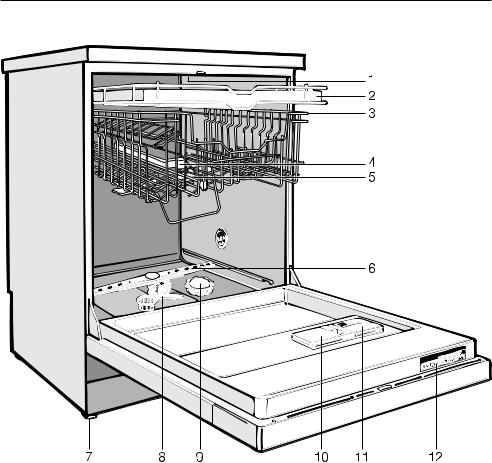
Guide to the dishwasher
Wash cabinet
1 |
Upper spray arm (not visible) |
7 |
Four height adjustable feet |
2 |
Cutlery tray |
8 |
Triple Filter System |
3 |
Upper basket |
9 |
Salt reservoir |
4 |
Water feed for |
10 |
Detergent dispenser |
|
the middle spray arm |
11 |
Rinse aid reservoir |
|
|
||
5 |
Middle spray arm |
|
(with dosage selector) |
6 |
Lower spray arm |
12 |
Data plate |
11
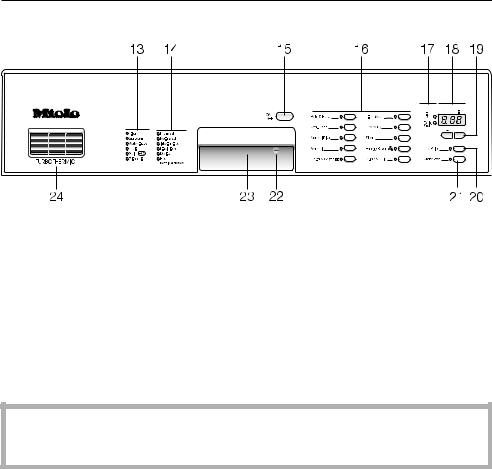
Guide to the dishwasher
Control panel
13 |
Check/Refill indicators |
19 |
Plus / Minus time buttons |
14 |
Program sequence display |
20 |
"Top solo" button |
15 |
"On/Off" button |
21 |
"Start/Stop" button |
16 |
Program list / indicators |
22 |
Child Safety Lock |
17 |
"Time left"/"Delay Start" indicators |
23 |
Door release |
18 |
Time display |
24 |
Drying vent |
Every dishwasher is tested before leaving the factory. Any water remaining in the machine is from these tests and does not indicate that the machine has been used.
12
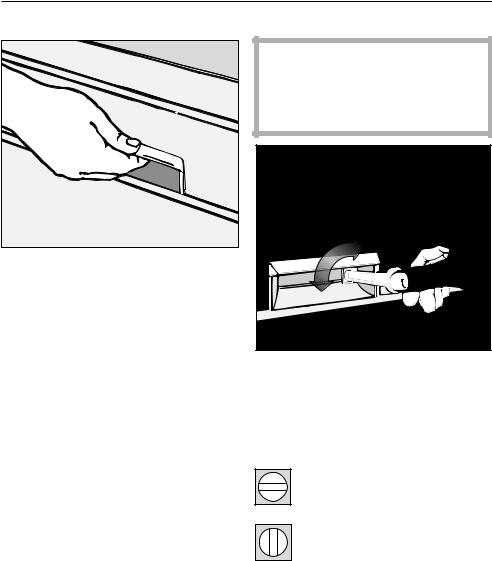
Before using for the first time
To open the door |
Child Safety Lock |
^Press the release catch inside the door grip.
If the door is opened during operation, the dishwasher will stop running. Once the door is closed the program will restart.
To close the door
^Push the baskets in.
^Lift the door and push until it clicks into position.
The yellow key for the Child Safety Lock is shipped on one of the spikes at the front of the upper basket. Remove the key before using the dishwasher.
The Child Safety Lock is designed to prevent children from opening the dishwasher.
^Use the provided key to lock or unlock the dishwasher.
Horizontal:
the door is locked
Vertical:
the door can be opened
13

Before using for the first time
Water softener
To achieve good cleaning results, the dishwasher needs soft water. Hard water results in calcium deposits on dishware and in the dishwasher.
If your tap water hardness is above
8 gr/gal (140 ppm), the water should be softened. This takes place automatically in the unit’s integrated water softener.
–Your local water authority will be able to advise you of the water hardness level in your area.
–The water softener must be filled with dishwasher salt for reactivation.
If your water hardness is lower than
8 gr/gal (140 ppm), you do not need to add dishwasher salt.
If there is a fault, it will help the service technician to know the hardness of your local water supply.
^ Enter the water hardness below:
gr/gal (ppm)
Settings
gr/gal* |
ppm |
Value shown in |
|
|
the time display |
|
|
|
1 |
20 |
1 |
2 |
40 |
2 |
3 |
50 |
3 |
4** |
70 |
4 |
5 |
90 |
5 |
6 |
110 |
6 |
7 |
130 |
7 |
8 |
140 |
8 |
9 |
160 |
9 |
10 |
180 |
10 |
11 |
200 |
11 |
12 |
220 |
12 |
13 |
230 |
13 |
14 |
250 |
14 |
15 |
270 |
15 |
16 |
290 |
16 |
17 |
310 |
17 |
18 |
320 |
18 |
19 |
340 |
19 |
20 |
360 |
20 |
21 |
380 |
21 |
22 |
400 |
22 |
23 |
410 |
23 |
24 |
430 |
24 |
25 |
450 |
25 |
26 |
470 |
26 |
27 |
490 |
27 |
28 |
500 |
28 |
29 |
520 |
29 |
30 |
540 |
30 |
31 |
560 |
31 |
32 |
580 |
32 |
33 |
590 |
33 |
34 |
610 |
34 |
35 |
630 |
35 |
36-70 |
650-1260 |
36 |
|
|
|
*US gallons
**4 gr/gal (70 ppm) is factory preset
14
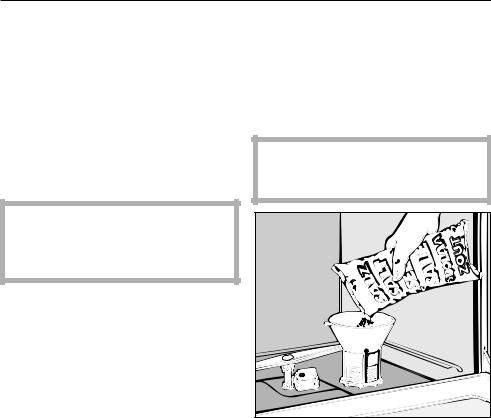
Before using for the first time
Filling the salt reservoir
If your water hardness level is greater than 8 gr/gal, the salt reservoir should be filled before the first use and when the "Salt" indicator lights.
Only use water softener salt (1 - 4 mm) grain size; other salts may contain insoluble additives which can impair the water softener.
,Inadvertently filling the salt reservoir with dishwashing detergent will damage the water softener.
To fill the salt reservoir:
^Remove the lower basket.
^Unscrew and remove the salt reservoir cap.
^Place the provided funnel over the salt reservoir.
Only before adding salt for the first time, fill the reservoir with approximately 2 quarts (2 l) of water.
^Carefully fill with salt, grain size of 1 - 4 mm. The salt reservoir holds approximately 4.5 lbs (2 kg) of salt. As it is filled, water will run out.
^Clean any excess salt from the threads of the reservoir opening.
^Screw the cap on firmly.
^If the dishwasher will not be used immediately, run the "Rinse & Hold" program. This will remove any traces of salt from inside the wash cabinet.
15
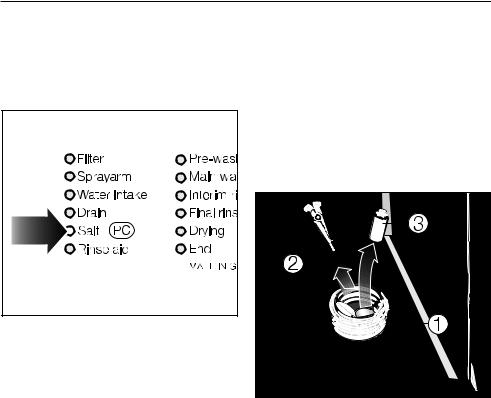
Before using for the first time
Salt indicator
When the salt reservoir is empty, the "Salt-PC" indicator will light, indicating that it should be refilled with reactivation salt.
After the reservoir has been filled, the water softener is automatically reactivated the next time the dishwasher is started. The "Salt" indicator will light during this process.
Bypassing the salt indicator
If your water is soft (below 8 gr/gal) the salt reservoir should not be filled with salt. The indicator will remain lit and should be disregarded or bypassed.
^ Remove the salt reservoir cap.
Looking into the salt reservoir, you will see the top of the float chamber on the right hand side, a.
^Using a screwdriver, carefully pivot the float chamber towards the center of the reservoir.
^Using needle nose pliers, first pull the cap, b, off of the float chamber, then remove the float, c.
^Replace the float chamber cap, push the chamber back into its upright position, and replace the salt reservoir cap. The indicator should not light.
16
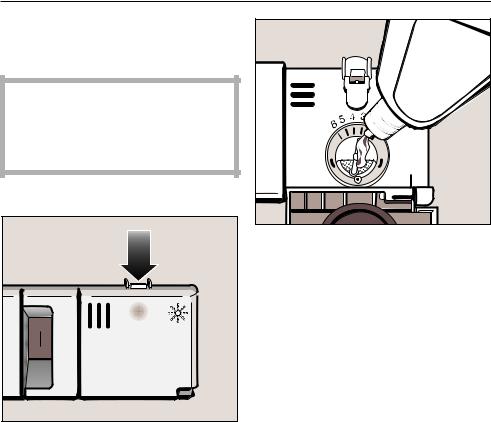
Before using for the first time
Rinse aid
Rinse aid is recommended to prevent spotting on dishes and glassware.
,Filling the rinse aid reservoir with detergent will damage the reservoir. Only pour rinse aid formulated for residential dishwashers into the reservoir.
Adding rinse aid
^Add rinse aid before the first use and whenever the "Rise aid" indicator lights.
^Press the button in the direction of the arrow until the flap springs open.
^Pour liquid rinse aid into the reservoir until it is visible on the surface of the screen.
^Press on the flap until you hear it click shut. Failure to close it all the way will allow water to enter the reservoir during the wash program.
^Wipe up any spilled rinse aid. The flap will remain closed during normal operation.
17
